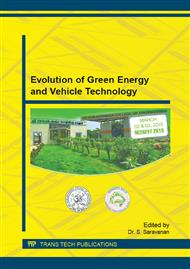[1]
Plunkett JW. Plunkett's automobile industry almanac 2008: automobile, truck and specialty vehicle industry market research, statistics, trends & leading companies. Houston (Texas): Plunkett Research Ltd.; (2007).
Google Scholar
[2]
Nadir Yilmaz, Francisco M. Vigil , A. Burl Donaldson , Tariq Darabseh , Investigation of CI engine emissions in biodiesel–ethanol–diesel blends as a function of ethanol concentration , Fuel 115 (2014) 790–793.
DOI: 10.1016/j.fuel.2013.08.012
Google Scholar
[3]
Opat R, Ra Y, Gonzalez MA, Krieger R, Reitz RD, Foster DE, et al. Investigation of mixing and temperature effects on HC/CO emissions for highly dilute low temperature combustion in a light duty diesel engine. SAE tech paper; 2007. SAE 2007-01-0193.
DOI: 10.4271/2007-01-0193
Google Scholar
[4]
Bobba MK, Musculus MPB. Laser diagnostics of soot precursors in a heavy-duty diesel engine at low-temperature combustion conditions. Combustion Flame 2012; 159: 832–43.
DOI: 10.1016/j.combustflame.2011.07.017
Google Scholar
[5]
Dorado MP, Ballesteros E, Arnal JM, Lopez FJ. Exhaust emissions from a diesel engine fueled with transesterified waste olive oil. Fuel 2003; 82: 1311–5.
DOI: 10.1016/s0016-2361(03)00034-6
Google Scholar
[6]
Yao YC, Tsai JH, Chiang HL. Effects of ethanol-blended gasoline on air pollutant emissions from motor cycle. Science Total Environment 2009; 407: 5257–62.
DOI: 10.1016/j.scitotenv.2009.06.017
Google Scholar
[7]
Park SH, Kim SH, Lee CS. Mixing stability and spray behavior characteristics of diesel ethanol methyl ester blended fuels in a common-rail diesel injection system. Energy Fuels 2009; 23(10): 5228–35.
DOI: 10.1021/ef9004847
Google Scholar
[8]
Kwanchareon P, Luengnaruemitchai A, Jai-In S. Solubility of a diesel–biodiesel–ethanol blend, its properties, and its emission characteristics from diesel engine. Fuel 2007; 86: 1053–61.
DOI: 10.1016/j.fuel.2006.09.034
Google Scholar
[9]
Lapuerta M, Armas O, Garcia-Contreras R. Stability of diesel–bioethanol blends for use in diesel engines. Fuel 2007; 86: 1351–7.
DOI: 10.1016/j.fuel.2006.11.042
Google Scholar
[10]
Su Han Park, Junepyo Cha, Chang Sik Lee … Impact of biodiesel in bio-ethanol blended diesel on the engine performance and emissions characteristics in compression ignition engine, Applied Energy 99 (2012) 334–343.
DOI: 10.1016/j.apenergy.2012.05.050
Google Scholar
[11]
Guarieiro LLN, de Souza AF, Torres EA, de Andrade JB. Emission profile of 18 carbonyl compounds, CO., CO2, and NOx emitted by a diesel engine fuelled with diesel and ternary blends containing diesel, ethanol and biodiesel or vegetable oils. Atmosphere Environment 2009; 43(17): 2754–61.
DOI: 10.1016/j.atmosenv.2009.02.036
Google Scholar
[12]
Jha SK, Fernando S, Columbus E, Willcutt H. A comparative study of exhaust emissions using diesel–biodiesel–ethanol blends in new and used engines. Trans ASABE 2009; 52(2): 375–81.
DOI: 10.13031/2013.26821
Google Scholar
[13]
Barabas I, Todorut A, Baldean D. Performance and emission characteristics of an CI engine fueled with diesel–biodiesel–bioethanol blends. Fuel 2010; 89(12): 3827–32.
DOI: 10.1016/j.fuel.2010.07.011
Google Scholar


